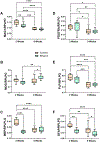Differential effects of moderate chronic ethanol consumption on neurobehavior, white matter glial protein expression, and mTOR pathway signaling with adolescent brain maturation
- PMID: 38847790
- PMCID: PMC11824867
- DOI: 10.1080/00952990.2024.2355540
Differential effects of moderate chronic ethanol consumption on neurobehavior, white matter glial protein expression, and mTOR pathway signaling with adolescent brain maturation
Abstract
Background: Adolescent brains are highly vulnerable to heavy alcohol exposure. Increased understanding of how alcohol adversely impacts brain maturation may improve treatment outcomes.Objectives: This study characterizes short-term versus long-term effects of ethanol feeding on behavior, frontal lobe glial proteins, and mTOR signaling.Methods: Adolescent rats (8/group) were fed liquid diets containing 26% or 0% ethanol for 2 or 9 weeks, then subjected to novel object recognition (NOR) and open field (OF) tests. Frontal lobes were used for molecular assays.Results: Significant ethanol effects on OF performance occurred in the 2-week model (p < .0001). Further shifts in OF and NOR performance were unrelated to ethanol exposure in the 9-week models (p < .05 to p < .0001). Ethanol inhibited MAG1 (p < .01) and MBP (p < .0001) after 2 but not 9 weeks. However, both control and ethanol 9-week models had significantly reduced MAG1 (p < .001-0.0001), MBP (p < .0001), PDGFRA (p < .05-0.01), and PLP (p < .001-0.0001) relative to the 2-week models. GFAP was the only glial protein significantly inhibited by ethanol in both 2- (p < .01) and 9-week (p < .05) models. Concerning the mTOR pathway, ethanol reduced IRS-1 (p < .05) and globally inhibited mTOR (p < .01 or p < .001) in the 9- but not the 2-week model.Conclusions: Short-term versus long-term ethanol exposures differentially alter neurobehavioral function, glial protein expression, and signaling through IRS-1 and mTOR, which have known roles in myelination during adolescence. These findings suggest that strategies to prevent chronic alcohol-related brain pathology should consider the increased maturation-related vulnerability of adolescent brains.
Keywords: Alcohol; adolescence; mTOR; oligodendrocytes; rat model; white matter.
Conflict of interest statement
Disclosure statement
The authors have no conflicts of interest related to the content of this manuscript.
Figures










Similar articles
-
Progressive Alcohol-Related Brain Atrophy and White Matter Pathology Are Linked to Long-Term Inhibitory Effects on mTOR Signaling.Biomolecules. 2025 Mar 14;15(3):413. doi: 10.3390/biom15030413. Biomolecules. 2025. PMID: 40149949 Free PMC article.
-
Shenzhiling oral liquid protects the myelin sheath against Alzheimer's disease through the PI3K/Akt-mTOR pathway.J Ethnopharmacol. 2021 Oct 5;278:114264. doi: 10.1016/j.jep.2021.114264. Epub 2021 Jun 1. J Ethnopharmacol. 2021. PMID: 34082015
-
Intermittent voluntary ethanol consumption combined with ethanol vapor exposure during adolescence increases drinking and alters other behaviors in adulthood in female and male rats.Alcohol. 2018 Dec;73:57-66. doi: 10.1016/j.alcohol.2018.04.003. Epub 2018 Apr 18. Alcohol. 2018. PMID: 30293056 Free PMC article.
-
Adolescent alcohol exposure: Are there separable vulnerable periods within adolescence?Physiol Behav. 2015 Sep 1;148:122-30. doi: 10.1016/j.physbeh.2015.01.027. Epub 2015 Jan 23. Physiol Behav. 2015. PMID: 25624108 Free PMC article. Review.
-
Molecular and behavioral aspects of the actions of alcohol on the adult and developing brain.Crit Rev Clin Lab Sci. 2011 Jan-Feb;48(1):19-47. doi: 10.3109/10408363.2011.580567. Crit Rev Clin Lab Sci. 2011. PMID: 21657944 Review.
Cited by
-
Chondrosarcoma: Multi-Targeting Therapeutic Effects of Doxorubicin, BEZ235, and the Small Molecule Aspartyl-Asparaginyl-β-hydroxylase Inhibitor SMI1182.Cancers (Basel). 2025 May 15;17(10):1671. doi: 10.3390/cancers17101671. Cancers (Basel). 2025. PMID: 40427168 Free PMC article.
-
Progressive Alcohol-Related Brain Atrophy and White Matter Pathology Are Linked to Long-Term Inhibitory Effects on mTOR Signaling.Biomolecules. 2025 Mar 14;15(3):413. doi: 10.3390/biom15030413. Biomolecules. 2025. PMID: 40149949 Free PMC article.
-
Early-Stage Moderate Alcohol Feeding Dysregulates Insulin-Related Metabolic Hormone Expression in the Brain: Potential Links to Neurodegeneration Including Alzheimer's Disease.J Alzheimers Dis Rep. 2024 Sep 5;8(1):1211-1228. doi: 10.3233/ADR-240026. eCollection 2024. J Alzheimers Dis Rep. 2024. PMID: 39247872 Free PMC article.
References
MeSH terms
Substances
Grants and funding
LinkOut - more resources
Full Text Sources
Research Materials
Miscellaneous
